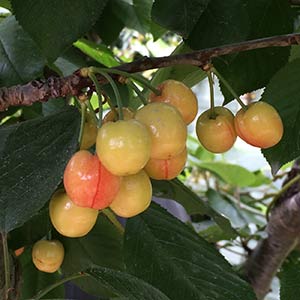
If you like cherries, then you will absolutely love cherries from your own tree. It simply a matter of picking them at right moment . And of course you need to choose the right type of cherry tree for your climate.
The two main types of cherry trees are Prunus avium (Sweet Cherries) and Prunus cerasus (Tart or Sour Cherries) . The easiest to grow in most zones are the Tart Cherries.
Sweet Cherries need an environment where they do not get frosts in Fall and where Summers are reliable warm and dry.
Cherry trees do require pruning to keep them at a height where it is easy to harvest the fruit, generally at around 15ft is the limit. With good conditions and the right pruning an individual mature cherry tree can produce over 5000 individual cherries.
These are a tree that need to be spaced to maximise production, ideally 30 ft – 40 ft apart. This allows good air flow and easy access. Of course with limited space you can plant them closer, however 20ft is as about as close as we would go, unless you are planting the dwarf types.
Care
Its all about bloom time and frosts. Cherry trees bloom early, and the sweet ones extra early, frost can kill the blossom, and therefore no fruit set.
Grown more widely as a commercial crop rather than in the home garden, Cherry Trees (Prunus Avium) come in a range of varieties and are generally suited to zones 4-9 depending on cultivar and local conditions.
General Care Notes
- Check with your supplier that the Cherry Tree you are about to buy is suited to your climate zone.
- Ensure that you are planting your tree in a sunny position in a well drained soil.
- Check the need for a pollinator, although cherry trees are mostly self pollinating, you will usually get better crops with a cross pollinator.
- What you are looking for is varieties that have similar bloom times.
- Plant in late summer to early fall, this gives time for a little root development
- Best in a sheltered position.
- Stake young trees to help with root development.
- Mulch to retain moisture and control weed
- Water in well with a liquid seaweed fertilizer
- Consider setting up a netting system to keep the birds away
- Water during spring and early summer if required
Varieties
Generally 2 types, Sweet and Tart.
The Tart varieties are generally self pollinating while most of the sweet varieties require cross pollination except for Black Gold and Lapins
Sweet Cherry Tree Varieties
- Bing
- Black Tartarian
- Black Gold
- White Gold
- Celeste
- Early Richmond
- Hartland
- Lapins
- Rainier
- Royalton
- Satin
- Stella
- Summit
- Sweetheart
Tart or Sour Cherry Tree Varieties
- Montmorency
- English Morello
- North Star
- Schatten
- Danube
Dwarf Cherry Trees
You can also get Dwarf and Semi Dwarf Varieties. These will get to around 12’ in height, even less if container grown. These types are excellent for home gardens. They will produce masses of fruit and are easier to care for.
Best Cherry Trees for Home Gardens
If we were going to choose one variety for the home garden it would most likely be ‘Stella’.
Good dark fleshed fruits, reliable and sweet.
This is a smaller growing variety that will crop after 2 years and reach a high level of fruit production after four years.
An excellent variety for growing in containers.
Picking Cherries
It is so tempting to pick cherries earlier than you should. Ideally wait until the sugar levels are high, just as the start to turn that deeper red.
Cherry trees are available for sale from the following specialist nurseries.
STARK Bro’s NURSERIES& ORCHARDS Co.
PO Box 1800 Louisiana MO 63353 – phone: 1-800-325-4180
Originators of Red and Golden Delicious apples. Full line of fruit, Apricots, Berries, Cherries, Nectarines, Pears, Grapes, Nuts, shade and flowering trees, shrubs roses and small fruits. Includes: Walnuts, Carpathian English Walnut, Lake English Walnut, Black Walnut and others
www.starkbros.com

